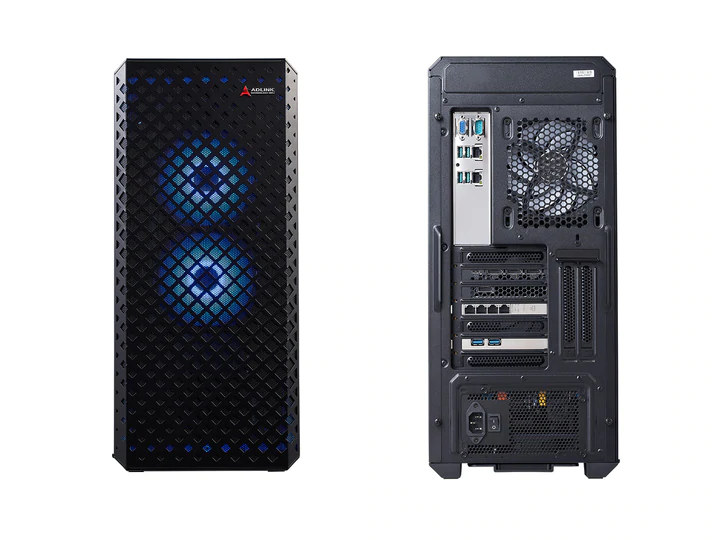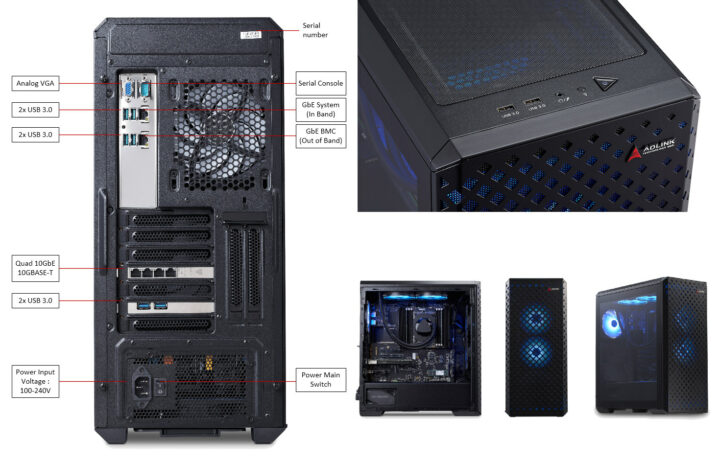ADLINK has just announced the availability of the Arm SystemReady SR-certified Ampere Altra Developer Platform equipped with the company’s COM-HPC Ampere Altra module with 32 to 80 64-bit Arm Neoverse N1 cores, 32GB to 128GB RAM.
An adaptation to the earlier AVA Developer Platform expected to sell for $5,450, the Ampere Altra Developer Platform got a price cut to $3,999 at launch for a system with a 32-core processor, and 32GB DDR4. The system targets software developers wanting to build cloud-to-edge applications using standardized Arm hardware.
 Ampere Altra Developer Platform specifications:
Ampere Altra Developer Platform specifications:
- SoM – COM-HPC Ampere Altra module with Ampere Altra 32 to 80-core 64-bit Arm Neoverse N1 processor up to 1.7/2.2/2.6 GHz (32/64/80 cores, TPD: 60W to 175W), 32 GB to 128GB DDR4 ECC memory
- Storage – 128 GB NVMe M.2 SSD
- Mainboard – COM-HPC Server Base carrier board
- Video – VGA port
- Audio – 3.5mm audio jack
- Networking
- 1x Gigabit Ethernet
- 1x RJ45 console port for BMC
- Optional Intel Quad X710 10GbE LAN card
- Expansion – 3x PCIe x16 slots
- USB – 6x or 4x USB 3.0 ports [rear I/O], 2x USB 2.0 ports [top panel]
- Serial – COM port (DB9)
- Misc
- Power main switch, power button
- LED button to toggle through the LED lighting modes of the 5 ARGB system fans, which consist of 12 colored lighting effects and off
- Optional liquid cooling for silent, fanless operation
- Power Supply – 750 Watt power supply
- Dimensions – Standard tower enclosure
Arm SystemReady SR compliance ensures out-of-the-box support for off-the-shelf operating systems, and the machine has been tested successfully with Ubuntu Server 20.04.3, Windows PE (10.0.22000.1), VMware ESXi-Arm Fling v1.8, Fedora Server 35, FreeBSD 13.0-RELEASE, CentOS stream 9, and Debian 11.2. Arm SystemReady SR is for servers and workstations and has no waivers (for hardware/firmware/OS hacks) like Arm SystemReady ES or SystemReady IR certifications do for less powerful systems. Documentation can be found on the Wiki.
The Ampere Altra Developer Platform can be purchased on IPI Wiki store for $3,999 with a large part of the cost-cutting, compared to the AVA Developer Platform, coming from the lack of the Quad-10GbE card (by default). ADLINK told CNX Software the 32GB RAM, 32 cores model currently sold is in mass production, and more powerful models are expected at the end of Q2 2022 for $5,399 with 64 cores and 64GB DDR4, and $6,299 with 80 cores and 128GB DDR4.

Jean-Luc started CNX Software in 2010 as a part-time endeavor, before quitting his job as a software engineering manager, and starting to write daily news, and reviews full time later in 2011.
Support CNX Software! Donate via cryptocurrencies, become a Patron on Patreon, or purchase goods on Amazon or Aliexpress







I just got confirmation of the differences between AVA and the new platform:
el cheepo – definitely not
> 64-bit Arm Neoverse N1 processor up to 1.7/2.2/2.6 GHz (32/64/80 cores
Shouldn’t it read ‘2.6/2.2/1.7 GHz’ instead assuming the 32 core version being allowed to clock up to 2.6 GHz while 80 cores can’t exceed 1.7 GHz when all cores are busy?
Hmm… nope, they write ’32 Arm v8.2 64-bit cores up to 1.7GHz or 64 Arm v8.2 64-bit cores up to 2.2GHz or 80 Arm v8.2 64-bit cores up to 2.6GHz (optional)’. Strange, especially when comparing with the advertised ‘TPD: 60W to 175W’
ADLINK says the 32-core SoC clocks at up to 1.7 GHz, the 64-core SoC at 2.2 GHz, and the 80-core SoC at 2.6 GHz. That seems counter-intuitive, but maybe it’s possible with the higher TDP? Plus those may be peak single-core frequencies. Not sure.
Yeah, I agree. Most probably it’s about binning (the 32-core SoC coming from low quality wafers, therefore limited wrt clockspeeds and enabled cores) and also just about single-core peak clocks.
Since the little that I know about DVFS suggests that if 32 cores at 1.7 GHz need 60W, the same 32 cores at 2.6 GHz need twice as much so there’s no way to stay within those TDP limits with 80 cores at 2.6 GHz.
Well Arm want the server market as that’s where the money is, and wise folk say Mobile Phone market saturated. ( there at least three more markets Arm ignore ). Anyway Arm should do a affordable board with socket for Apple M1 type level chips with, PCIE, SATA etc. Affordable £99-£160.
But they won’t 🤔😮😥
depends on the customer side